前置知识:
- 掌握Java基础知识(特别是反射)
- 掌握Java注解
- 掌握XML
- 掌握Maven
Spring5学习笔记
1、Spring概述
1.1、简介
简化企业开发的复杂性
Spring理念:使现有的技术更加容易使用,本身是一个大杂烩,整合了现有的技术框架。
- SSH:Struct2 + Spring + Hibernate
- SSM:Spring MVC + Spring + MyBatis
官网 : http://spring.io/
官方下载地址 : https://repo.spring.io/libs-release-local/org/springframework/spring/
GitHub : https://github.com/spring-projects
1.2、优点
- Spring是一个开源的免费的框架(集合)
- Spring是一个轻量级的、非入侵式的框架
- 控制反转(IoC)、面向切面编程(AOP)
- 支持事务的处理,对框架整合的支持
总结一句话:Spring就是一个轻量级的控制反转(IoC)和面向切面编程(AOP)的框架。
1.3、组成
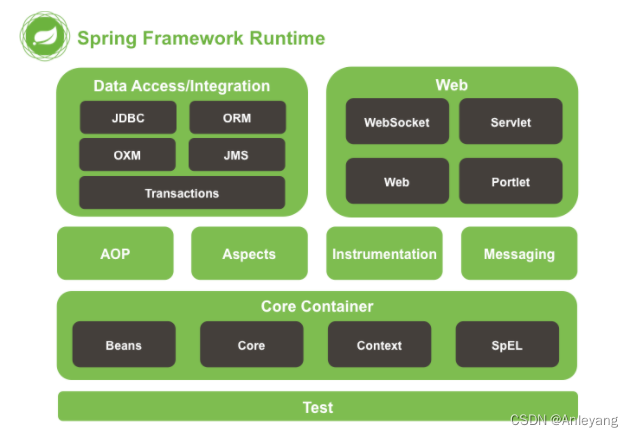
Spring 框架是一个分层架构,由 7 个定义良好的模块组成。Spring 模块构建在核心容器之上,核心容器定义了创建、配置和管理 bean 的方式。
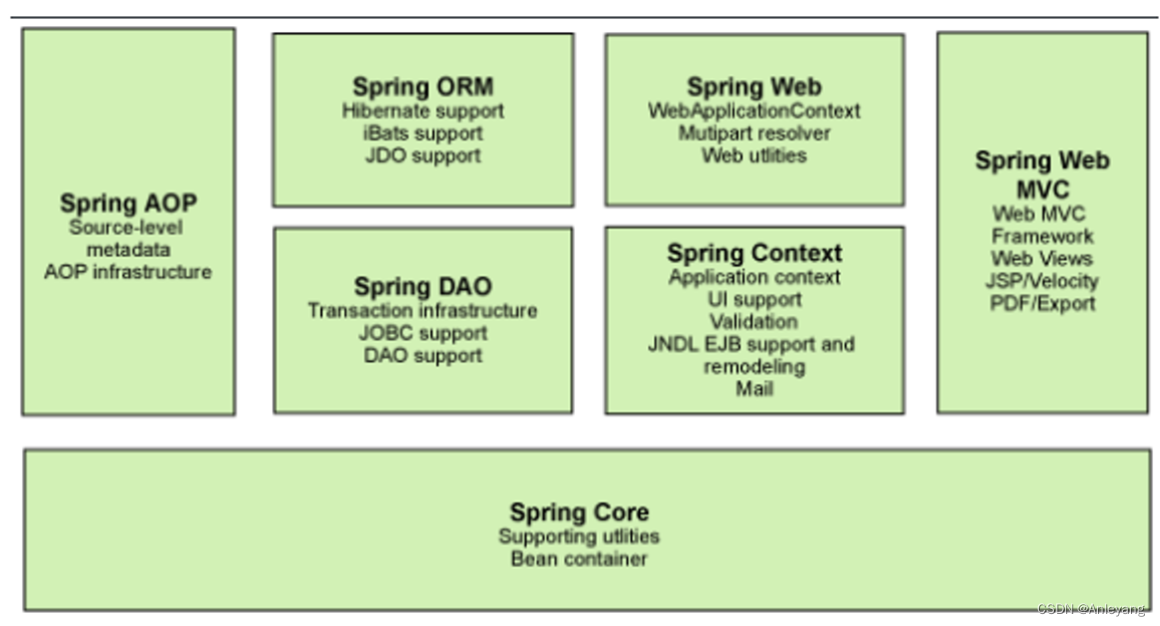
组成 Spring 框架的每个模块(或组件)都可以单独存在,或者与其他一个或多个模块联合实现。每个模块的功能如下:
- 核心容器:核心容器提供 Spring 框架的基本功能。核心容器的主要组件是 BeanFactory,它是工厂模式的实现。BeanFactory 使用控制反转(IOC) 模式将应用程序的配置和依赖性规范与实际的应用程序代码分开。
- Spring 上下文:Spring 上下文是一个配置文件,向 Spring 框架提供上下文信息。Spring 上下文包括企业服务,例如 JNDI、EJB、电子邮件、国际化、校验和调度功能。
- Spring AOP:通过配置管理特性,Spring AOP 模块直接将面向切面的编程功能 , 集成到了 Spring 框架中。所以,可以很容易地使 Spring 框架管理任何支持 AOP的对象。Spring AOP 模块为基于 Spring 的应用程序中的对象提供了事务管理服务。通过使用 Spring AOP,不用依赖组件,就可以将声明性事务管理集成到应用程序中。
- Spring DAO:JDBC DAO 抽象层提供了有意义的异常层次结构,可用该结构来管理异常处理和不同数据库供应商抛出的错误消息。异常层次结构简化了错误处理,并且极大地降低了需要编写的异常代码数量(例如打开和关闭连接)。Spring DAO 的面向 JDBC 的异常遵从通用的 DAO 异常层次结构。
- Spring ORM:Spring 框架插入了若干个 ORM 框架,从而提供了 ORM 的对象关系工具,其中包括 JDO、Hibernate 和 iBatis SQL Map。所有这些都遵从 Spring 的通用事务和 DAO 异常层次结构。
- Spring Web 模块:Web 上下文模块建立在应用程序上下文模块之上,为基于 Web 的应用程序提供了上下文。所以,Spring 框架支持与 Jakarta Struts 的集成。Web 模块还简化了处理多部分请求以及将请求参数绑定到域对象的工作。
- Spring MVC 框架:MVC 框架是一个全功能的构建 Web 应用程序的 MVC 实现。通过策略接口,MVC 框架变成为高度可配置的,MVC 容纳了大量视图技术,其中包括 JSP、Velocity、Tiles、iText 和 POI。
1.4、拓展
现代化的Java开发,说白就是基于Spring的开发。

- Spring Boot
- 一个快速开发的脚手架
- 基于SpringBoot可以快速开发单个微服务
- 约定大于配置
- Spring Cloud
- SpringCloud是基于SpringBoot实现的
因为现在大多数公司都在使用SpringBoot进行快速开发,学习SpringBoot的前提,需要完全掌握Spring及SpringMVC。
承上启下的作用。
弊端:发展了太久之后,违背了原来的理念。配置十分繁琐,人称“配置地狱”。
2、IOC理论推导
2.1、分析实现
- UserDao接口
- UserDaolmpl实现类
- UserService业务接口
- UserService业务实现类
在我们之前的业务中,用户的需求可能会影响我们原来的代码,我们需要根据用户的需求去修改原代码。如果程序代码量十分大,修改一次的成本代价十分昂贵!
我们使用一个Set接口实现,已经发生了革命性的变化。
private UserDao userDao;
//set方法:利用set进行动态实现值的注入
public void setUserDao(UserDao userDao) {
this.userDao = userDao;
}
之前,程序是主动创建对象,控制权在程序猿手上。
使用了set注入后,程序不再具有主动性,而是变成了被动的接受对象。
这种思想,从本质上解决了问题,我们程序猿不用再去管理对象的创建。系统的耦合性大大降低,可以更加专注的在业务的实现上。这是IOC的原型。
2.2、IOC本质
原本主动权在业务层在程序猿手上,set注入后主动权在用户手上,实现了控制反转。

控制反转IoC(Inversion of Control),是一种设计思想,DI(依赖注入)是实现IoC的一种方法,也有人认为DI只是IoC的另一种说法。没有IoC的程序中 , 我们使用面向对象编程 , 对象的创建与对象间的依赖关系完全硬编码在程序中,对象的创建由程序自己控制,控制反转后将对象的创建转移给第三方,个人认为所谓控制反转就是:获得依赖对象的方式反转了。

IoC是Spring框架的核心内容,使用多种方式完美的实现了IoC,可以使用XML配置,也可以使用注解,新版本的Spring也可以零配置实现IoC。
采用XML方式配置Bean的时候,Bean的定义信息是和实现分离的,而采用注解的方式可以把两者合为一体,Bean的定义信息直接以注解的形式定义在实现类中,从而达到了零配置的目的。
控制反转是一种通过描述(XML或注解)并通过第三方去生产或获取特定对象的方式。在Spring中实现控制反转的是IoC容器,其实现方法是依赖注入(Dependency Injection,DI)。
3、HelloSpring
3.1、导入jar包
注 : spring 需要导入commons-logging进行日志记录 . 我们利用maven , 他会自动下载对应的依赖项
<dependency>
<groupId>org.springframework</groupId>
<artifactId>spring-webmvc</artifactId>
<version>5.1.10.RELEASE</version>
</dependency>
3.2、编写代码
编写一个Hello实体类
public class Hello {
private String name;
public String getName() {
return name;
}
public void setName(String name) {
this.name = name;
}
public void show(){
System.out.println("Hello,"+ name );
}
}
编写我们的spring文件 , 这里我们命名为beans.xml
<?xml version="1.0" encoding="UTF-8"?>
<beans xmlns="http://www.springframework.org/schema/beans"
xmlns:xsi="http://www.w3.org/2001/XMLSchema-instance"
xsi:schemaLocation="http://www.springframework.org/schema/beans
https://www.springframework.org/schema/beans/spring-beans.xsd">
<!--使用Spring来创建对象,在Spring这些都称为Bean
类型 变量名 = new 类型();
Hello hello = new Hello();
id = 变量名;
class = new 的对象;
property 相当于给对象中的属性设置一个值
-->
<!--使用Spring来创建对象,在Spring中这些都称为Bean-->
<bean id = "hello" class = "com.shelly.pojo.Hello">
<property name = "name" value = "Spring"/>
</bean>
</beans>
我们可以去进行测试了
@Test
public void test(){
//解析beans.xml文件 , 生成管理相应的Bean对象
ApplicationContext context = new ClassPathXmlApplicationContext("beans.xml");
//getBean : 参数即为spring配置文件中bean的id .
Hello hello = (Hello) context.getBean("hello");
hello.show();
}
3.3、思考
- Hello 对象是谁创建的 ? 【 hello 对象是由Spring创建的 】
- Hello 对象的属性是怎么设置的 ? 【hello 对象的属性是由Spring容器设置的 】
这个过程就叫控制反转 :
- 控制 : 谁来控制对象的创建 , 传统应用程序的对象是由程序本身控制创建的 , 使用Spring后 , 对象是由Spring来创建的
- 反转 : 程序本身不创建对象 , 而变成被动的接收对象 .
依赖注入 : 就是利用set方法来进行注入的.
IOC是一种编程思想,由主动的编程变成被动的接收
可以通过newClassPathXmlApplicationContext去浏览一下底层源码 .
3.4、修改案例一
我们在案例一中, 新增一个Spring配置文件beans.xml
<?xml version="1.0" encoding="UTF-8"?>
<beans xmlns="http://www.springframework.org/schema/beans"
xmlns:xsi="http://www.w3.org/2001/XMLSchema-instance"
xsi:schemaLocation="http://www.springframework.org/schema/beans
https://www.springframework.org/schema/beans/spring-beans.xsd">
<bean id="mysqllimpl" class="com.shelly.dao.UserDaoMySQLlmpl"/>
<bean id="oraclelimpl" class="com.shelly.dao.UserDaoMySQLlmpl"/>
<bean id="UserServiceImpl" class="com.shelly.service.UserServiceImp1">
<!--
ref:引用Spring容器中创建好的对象
value:具体的值,基本数据类型
-->
<property name="userDao" ref="mysqllimpl"/>
</bean>
</beans>
测试!
import com.shelly.dao.UserDaoImp1;
import com.shelly.dao.UserDaoMySQLlmpl;
import com.shelly.dao.UserDaoOracleimpl;
import com.shelly.service.UserService;
import com.shelly.service.UserServiceImp1;
import org.springframework.context.ApplicationContext;
import org.springframework.context.support.ClassPathXmlApplicationContext;
/**
* ClassName: MyTest
* Package: PACKAGE_NAME
* Description
*
* @Author Shelly
* @Create 2023/5/10 22:45
* @Version 1.0
*/
public class MyTest {
public static void main(String[] args) {
// //用户实际调用的是业务层,dao层他们不需要接触
// UserService userService = new UserServiceImp1();
//
// //((UserServiceImp1) userService).setUserDao(new UserDaoMySQLlmpl());
// ((UserServiceImp1) userService).setUserDao(new UserDaoOracleimpl());
// userService.getUser();
//
//获取ApplicationContext:拿到Spring的容器
ApplicationContext context = new ClassPathXmlApplicationContext("beans.xml");
//容器在手,天下我有,需要什么,就直接get什么
UserServiceImp1 userServiceImpl = (UserServiceImp1) context.getBean("UserServiceImpl");
userServiceImpl.getUser();
}
}
OK , 到了现在 , 我们彻底不用再程序中去改动了 , 要实现不同的操作 , 只需要在xml配置文件中进行修改 , 所谓的IoC,一句话搞定 : 对象由Spring 来创建 , 管理 , 装配 !
4、IOC创建对象的方式
4.1、使用无参构造创建对象(默认)
User.java
public class User {
private String name;
public User() {
System.out.println("user无参构造方法");
}
public void setName(String name) {
this.name = name;
}
public void show(){
System.out.println("name="+ name );
}
}
beans.xml
<?xml version="1.0" encoding="UTF-8"?>
<beans xmlns="http://www.springframework.org/schema/beans"
xmlns:xsi="http://www.w3.org/2001/XMLSchema-instance"
xsi:schemaLocation="http://www.springframework.org/schema/beans
https://www.springframework.org/schema/beans/spring-beans.xsd">
<bean id="user" class="com.shelly.pojo.User">
<property name="name" value="杨洋"/>
</bean>
</beans>
测试类
import com.shelly.pojo.User;
import org.springframework.context.ApplicationContext;
import org.springframework.context.support.ClassPathXmlApplicationContext;
/**
* ClassName: MyTest
* Package: PACKAGE_NAME
* Description
*
* @Author Shelly
* @Create 2023/5/11 10:52
* @Version 1.0
*/
public class MyTest {
public static void main(String[] args) {
ApplicationContext context = new ClassPathXmlApplicationContext("beans.xml");
//在执行getBean的时候, user已经创建好了 , 通过无参构造
User user = (User) context.getBean("user");
//调用对象的方法
user.show();
}
}
结果可以发现,在调用show方法之前,User对象已经通过无参构造初始化了!
4.2、使用有参构造创建对象
- 使用无参构造创建对象,默认!
- 假设我们要使用有参构造创建对象
-
下标赋值
<!-- 第一种根据index参数下标设置 --> <bean id="userT" class="com.kuang.pojo.UserT"> <!-- index指构造方法 , 下标从0开始 --> <constructor-arg index="0" value="kuangshen2"/> </bean> -
类型
2. `<!-- 第三种根据参数类型设置,不建议使用 -->` 3. `<bean id="userT" class="com.kuang.pojo.UserT">` 4. `<constructor-arg type="java.lang.String" value="kuangshen2"/>` 5. `</bean>` -
参数名
<!-- 第二种根据参数名字设置 --> <bean id="userT" class="com.kuang.pojo.UserT"> <!-- name指参数名 --> <constructor-arg name="name" value="kuangshen2"/> </bean>
-
总结:在配置文件加载的时候,容器中管理的对象就已经初始化了。
5、Spring配置
5.1、别名
alias 设置别名 , 为bean设置别名 , 可以设置多个别名
<!--设置别名:在获取Bean的时候可以使用别名获取-->
<alias name="userT" alias="userNew"/>
5.2、Bean的配置
<!--bean就是java对象,由Spring创建和管理-->
<!--
id 是bean的标识符,要唯一,如果没有配置id,name就是默认标识符
如果配置id,又配置了name,那么name是别名
name可以设置多个别名,可以用逗号,分号,空格隔开
如果不配置id和name,可以根据applicationContext.getBean(.class)获取对象;
class是bean的全限定名=包名+类名
-->
<bean id="hello" name="hello2 h2,h3;h4" class="com.kuang.pojo.Hello">
<property name="name" value="Spring"/>
</bean>
5.3、import
这个import,一般用于团队开发使用,他可以将多个配置文件,导入合并为一个
假设,现在项目中有多个人开发,这三个人复制不同的类开发,不同的类需要注册在不同的bean中,我们可以利用import将所有人的beans.xml合并为一个总的
-
张三
-
李四
-
王五
-
applicationContext.xml
<import resource="{path}/beans.xml"/>
使用的时候,直接使用总的配置就可以了。
6、依赖注入
6.1、构造器注入
前面4.1、4.2通过无参和有参的构造器注入
6.2、Set方式注入【重点】
- 依赖注入:Set注入
- 依赖:bean对象的创建依赖于容器
- 注入:bean对象中的所有属性,由容器来注入
【环境搭建】
-
复杂类型
public Address{ private String address; public string getAddress() { return address; } public void setAddress(Address address) { this.address = address; } } -
真实测试对象
public class Student { private String name; private Address address; private String[] books; private List<String> hobbys; private Map<String,String> card; private Set<String> games; private String wife; private Properties info; } -
beans.xml
<?xml version="1.0" encoding="UTF-8"?> <beans xmlns="http://www.springframework.org/schema/beans" xmlns:xsi="http://www.w3.org/2001/XMLSchema-instance" xsi:schemaLocation="http://www.springframework.org/schema/beans https://www.springframework.org/schema/beans/spring-beans.xsd"> <bean id="student" class="com.shelly.pojo.Student"> <!--第一种,普通值注入,value--> <property name="name" value="yangyang"/> </bean> </beans> -
Test测试
public class MyTest { public static void main(String[] args) { ApplicationContext context = new ClassPathXmlApplicationContext("beans.xml"); Student student = (Student) context.getBean("student"); student.getAddress(); } } -
完善注入信息
常量注入 <bean id="student" class="com.kuang.pojo.Student"> <property name="name" value="小明"/> </bean> Bean注入 =注意点:这里的值是一个引用,ref== <bean id="addr" class="com.kuang.pojo.Address"> <property name="address" value="重庆"/> </bean> <bean id="student" class="com.kuang.pojo.Student"> <property name="name" value="小明"/> <property name="address" ref="addr"/> </bean> 数组注入 <bean id="student" class="com.kuang.pojo.Student"> <property name="name" value="小明"/> <property name="address" ref="addr"/> <property name="books"> <array> <value>西游记</value> <value>红楼梦</value> <value>水浒传</value> </array> </property> </bean> List注入 <property name="hobbys"> <list> <value>听歌</value> <value>看电影</value> <value>爬山</value> </list> </property> Map注入 <property name="card"> <map> <entry key="中国邮政" value="456456456465456"/> <entry key="建设" value="1456682255511"/> </map> </property> set注入 <property name="games"> <set> <value>LOL</value> <value>BOB</value> <value>COC</value> </set> </property> Null注入 <property name="wife"><null/></property> Properties注入 <property name="info"> <props> <prop key="学号">20190604</prop> <prop key="性别">男</prop> <prop key="姓名">小明</prop> </props> </property>
测试结果:
![[外链图片转存失败,源站可能有防盗链机制,建议将图片保存下来直接上传(img-zD2lenKN-1685432472301)(2%20Spring5%E5%AD%A6%E4%B9%A0%E7%AC%94%E8%AE%B0%20d54d8b7c5f9445d69505971a33d5583e/Untitled%204.png)]](https://img-blog.csdnimg.cn/9a19fc86408543cab596494c36811a82.png)
6.3、拓展方式注入
我们可以使用p命令空间和c命令空间进行注入
官方解释:
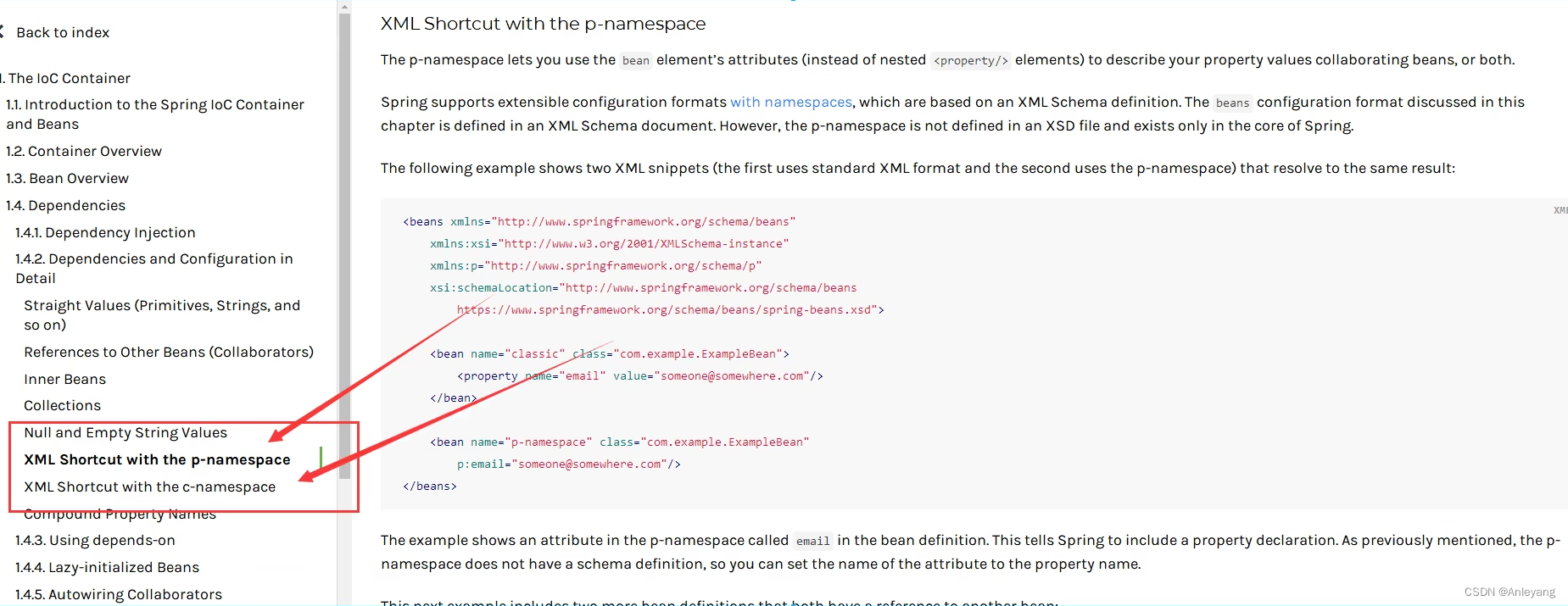
User.java : 【注意:这里没有有参构造器!】
public class User {
private String name;
private int age;
public void setName(String name) {
this.name = name;
}
public void setAge(int age) {
this.age = age;
}
@Override
public String toString() {
return "User{" +
"name='" + name + '\'' +
", age=" + age +
'}';
}
}
- p命名空间注入 : 需要在头文件中假如约束文件
导入约束 : xmlns:p="http://www.springframework.org/schema/p"
<!--P(属性: properties)命名空间 , 属性依然要设置set方法-->
<bean id="user" class="com.kuang.pojo.User" p:name="狂神" p:age="18"/>
- c 命名空间注入 : 需要在头文件中假如约束文件
导入约束 : xmlns:c="http://www.springframework.org/schema/c"
<!--C(构造: Constructor)命名空间 , 属性依然要设置set方法-->
<bean id="user" class="com.kuang.pojo.User" c:name="狂神" c:age="18"/>
发现问题:爆红了,刚才我们没有写有参构造!
解决:把有参构造器加上,这里也能知道,c 就是所谓的构造器注入!
测试:
@Test
public void test02(){
ApplicationContext context = new ClassPathXmlApplicationContext("applicationContext.xml");
User user = (User) context.getBean("user");
System.out.println(user);
}
注意点:p命名和c命名空间不能直接使用,需要导入xml约束。
6.4、Bean的作用域
官方解释:
![[外链图片转存失败,源站可能有防盗链机制,建议将图片保存下来直接上传(img-FqQHeHG5-1685432472301)(2%20Spring5%E5%AD%A6%E4%B9%A0%E7%AC%94%E8%AE%B0%20d54d8b7c5f9445d69505971a33d5583e/Untitled%206.png)]](https://img-blog.csdnimg.cn/04e3c080c35f40fabeb6c4dccee356a8.png)
![[外链图片转存失败,源站可能有防盗链机制,建议将图片保存下来直接上传(img-rjS7q2ds-1685432472301)(2%20Spring5%E5%AD%A6%E4%B9%A0%E7%AC%94%E8%AE%B0%20d54d8b7c5f9445d69505971a33d5583e/Untitled%207.png)]](https://img-blog.csdnimg.cn/39249f8b33da4b09ad302c854b40cebb.png)
-
单例模式(Spring默认机制)
<bean id="ServiceImpl" class="cn.csdn.service.ServiceImpl" c:age="18" c:name="狂神“ scope="singleton"> -
原型模式:每次从容器中get的时候,都会产生一个新对象
<bean id="account" class="com.foo.DefaultAccount" scope="prototype"/> 或者 <bean id="account" class="com.foo.DefaultAccount" singleton="false"/> -
其余的request、session、application:这些只能在web开发中使用到。
7、Bean的自动装配
- 自动装配是使用spring满足bean依赖的一种方法
- spring会在应用上下文中为某个bean寻找其依赖的bean。
Spring中bean有三种装配机制,分别是:
- 在xml中显式配置;
- 在java中显式配置;
- 隐式的bean发现机制和自动装配。【重点】
推荐不使用自动装配xml配置 , 而使用注解 .
7.1、测试
- 环境搭建:一个人有两个宠物
7.2、ByName自动装配
<?xml version="1.0" encoding="UTF-8"?>
<beans xmlns="http://www.springframework.org/schema/beans"
xmlns:xsi="http://www.w3.org/2001/XMLSchema-instance"
xsi:schemaLocation="http://www.springframework.org/schema/beans
https://www.springframework.org/schema/beans/spring-beans.xsd">
<bean id="cat" class="com.shelly.pojo.Cat"/>
<bean id="dog" class="com.shelly.pojo.Dog"/>
<!--
byName:会自动在容器上下文中查找,和自己对象set方法后面的值对应的beanid
byType:会自动在容器上下文查找,和自己对象属性类型相同的bean
-->
<bean id="people" class="com.shelly.pojo.People" autowire="byName">
<property name="name" value="yangyang"/>
</bean>
</beans>
7.3、ByType自动装配
<?xml version="1.0" encoding="UTF-8"?>
<beans xmlns="http://www.springframework.org/schema/beans"
xmlns:xsi="http://www.w3.org/2001/XMLSchema-instance"
xsi:schemaLocation="http://www.springframework.org/schema/beans
https://www.springframework.org/schema/beans/spring-beans.xsd">
<bean id="cat" class="com.shelly.pojo.Cat"/>
<bean id="dog" class="com.shelly.pojo.Dog"/>
<!--
byName:会自动在容器上下文中查找,和自己对象set方法后面的值对应的beanid
byType:会自动在容器上下文查找,和自己对象属性类型相同的bean
-->
<bean id="people" class="com.shelly.pojo.People" autowire="byType">
<property name="name" value="yangyang"/>
</bean>
</beans>
小结:
- byName的时候,需要保证所有bean的id唯一,并且这个bean需要和自动注入的属性的set方法的值一致。
- byTest的时候,需要保证所有bean的clas唯一,并且这个bean需要和自动注入的属性的类型一致。
7.4、使用注解实现自动装配
jdk1.5开始支持注解,spring2.5开始全面支持注解。
要使用注解须知:
-
导入约束
-
配置注解的支持【重要】
<context:annotation-config/>
xmlns:context="http://www.springframework.org/schema/context"
http://www.springframework.org/schema/context
http://www.springframework.org/schema/context/spring-context.xsd
@Autowrited
直接在属性上使用即可。
也可以在set方式上使用。
使用Autowrited我们可以不用编写Set方法里,前提是自动装配的属性在IOC(Spring)容器中存在,且符合名字byName
科普:
@Nullable 字段标记了这个注解,说明这个字段可以为null;
@Autowired(required=false) 说明: false,对象可以为null;true,对象必须存对象,不能为null。
//如果允许对象为null,设置required = false,默认为true
@Autowired(required = false)
private Cat cat;
如果@Autowired自动装配的环境比较复杂,自动装配无法通过一个注解【@Autowired】完成的时候,我们可以使用@Qualifier(value=”xxx”)去配置@Autowired的使用,指定一个唯一的bean对象注入!
@Qualifier
- @Autowired是根据类型自动装配的,加上@Qualifier则可以根据byName的方式自动装配
- @Qualifier不能单独使用。
@Resource
- @Resource如有指定的name属性,先按该属性进行byName方式查找装配;
- 其次再进行默认的byName方式进行装配;
- 如果以上都不成功,则按byType的方式自动装配。
- 都不成功,则报异常。
public class User {
//如果允许对象为null,设置required = false,默认为true
@Resource(name = "cat2")
private Cat cat;
@Resource
private Dog dog;
private String str;
}
小结:
- @Autowired与@Resource都可以用来装配bean。都可以写在字段上,或写在setter方法上。
- @Autowired默认按类型装配(属于spring规范),默认情况下必须要求依赖对象必须存在,如果要允许null 值,可以设置它的required属性为false,如:@Autowired(required=false) ,如果我们想使用名称装配可以结合@Qualifier注解进行使用
- @Resource(属于J2EE复返),默认按照名称进行装配,名称可以通过name属性进行指定。如果没有指定name属性,当注解写在字段上时,默认取字段名进行按照名称查找,如果注解写在setter方法上默认取属性名进行装配。 当找不到与名称匹配的bean时才按照类型进行装配。但是需要注意的是,如果name属性一旦指定,就只会按照名称进行装配。
它们的作用相同都是用注解方式注入对象,但执行顺序不同。@Autowired先byType,@Resource先byName。
- 都是用来自动装配的,都可以放在属性字段上
- @Autowired通过byType的方式实现,而且必须要求这个对象存在【常用】
- @Resource默认通过byName的方式实现,如果找不到名字,则通过byType实现。如果两个都找不到的情况下,就报错。【常用】
- 执行顺序不同:@Autowired通过byType的方式实现。@Resource默认通过byName的方式实现。
8、使用注解开发
8.1、说明
在spring4之后,想要使用注解形式,必须得要引入aop的包
![[外链图片转存失败,源站可能有防盗链机制,建议将图片保存下来直接上传(img-cDlWFL0t-1685432472302)(2%20Spring5%E5%AD%A6%E4%B9%A0%E7%AC%94%E8%AE%B0%20d54d8b7c5f9445d69505971a33d5583e/Untitled%208.png)]](https://img-blog.csdnimg.cn/511485d98fc04ac5b7f033c5aa357ca0.png)
在配置文件当中,还得要引入一个context约束
<?xml version="1.0" encoding="UTF-8"?>
<beans xmlns="http://www.springframework.org/schema/beans"
xmlns:xsi="http://www.w3.org/2001/XMLSchema-instance"
xmlns:context="http://www.springframework.org/schema/context"
xsi:schemaLocation="http://www.springframework.org/schema/beans
http://www.springframework.org/schema/beans/spring-beans.xsd
http://www.springframework.org/schema/context
http://www.springframework.org/schema/context/spring-context.xsd">
<context:annotation-config/>
</beans>
8.2、Bean的实现
-
bean
<?xml version="1.0" encoding="UTF-8"?> <beans xmlns="http://www.springframework.org/schema/beans" xmlns:xsi="http://www.w3.org/2001/XMLSchema-instance" xmlns:context="http://www.springframework.org/schema/context" xsi:schemaLocation="http://www.springframework.org/schema/beans http://www.springframework.org/schema/beans/spring-beans.xsd http://www.springframework.org/schema/context http://www.springframework.org/schema/context/spring-context.xsd"> <!--指定要扫描的包,这个包下的注解就会生效--> <context:component-scan base-package="com.shelly.pojo"/> <context:annotation-config/> <!--<bean id="user" class="com.shelly.pojo.User"/>--> <!-- <bean id="user" class="com.shelly.pojo.User"> <property name="name" value="yangyang"/> </bean>--> </beans> -
属性如何注入
package com.shelly.pojo; import org.springframework.beans.factory.annotation.Value; import org.springframework.stereotype.Component; /** * ClassName: User * Package: com.shelly.dao * Description * * @Author Shelly * @Create 2023/5/12 20:51 * @Version 1.0 */ //等价于<bean id="user" class="com.shelly.pojo.User"/> @Component public class User { public String name; //相当于<property name="name" value="yangyang"/> @Value("yangyang") public void setName(String name) { this.name = name; } } -
衍生的注解
@Component 有几个衍生注解,我们在web开发中,会按照mvc三层架构分层。
- dao 【@Repository】
- service【@Service】
- controller 【Controller 】
这四个注解功能都是一样的,都是代表将某个类注册到Spring中,装配Bean
-
自动装配置
- @Autowired:自动装配通过类型、名字 如果Autowired不能唯一自动装配上属性,则需要通过@Qualifier(value=”xxx”) - @Nullable 字段标记了这个注解,说明这个字段可以为null; - @Resource:自动装配通过名字、类型 -
作用域
- singleton:默认的,Spring会采用单例模式创建这个对象。关闭工厂 ,所有的对象都会销毁。
- prototype:多例模式。关闭工厂 ,所有的对象不会销毁。内部的垃圾回收机制会回收
@Controller("user") @Scope("prototype") public class User { @Value("秦疆") public String name; } -
小结
XML与注解:
- XML更加万能,适用于任何场合,维护简单方便
- 注解不是自己类使用不了,维护相对复杂
xml与注解整合开发 :推荐最佳实践
-
xml管理Bean
-
注解完成属性注入
-
使用过程中, 只需要注意一个问题:必须让注解生效,就需要开启注解的支持
<!--指定要扫描的包,这个包下的注解就会生效--> <context:component-scan base-package="com.shelly.pojo"/> <context:annotation-config/>
9、使用Java的方式配置Spring
我们现在要完全不使用Spring的xml配置了,全权交给Java来做。
JavaConfig 原来是 Spring 的一个子项目,它通过 Java 类的方式提供 Bean 的定义信息,在 Spring4 的版本, JavaConfig 已正式成为 Spring4 的核心功能 。
![[外链图片转存失败,源站可能有防盗链机制,建议将图片保存下来直接上传(img-uXaXuUEY-1685432472302)(2%20Spring5%E5%AD%A6%E4%B9%A0%E7%AC%94%E8%AE%B0%20d54d8b7c5f9445d69505971a33d5583e/Untitled%209.png)]](https://img-blog.csdnimg.cn/930089df58cf4149aeffbd5da908e3ec.png)
实体类
package com.shelly.pojo;
import org.springframework.beans.factory.annotation.Value;
import org.springframework.stereotype.Component;
/**
* ClassName: User
* Package: com.shelly.pojo
* Description
*
* @Author Shelly
* @Create 2023/5/12 21:36
* @Version 1.0
*/
//这里的注解:说明这个类被Spring接管类,注册到了容器中
@Component
public class User {
private String name;
public String getName() {
return name;
}
@Value("YangYang") //属性注入值
public void setName(String name) {
this.name = name;
}
@Override
public String toString() {
return "User{" +
"name='" + name + '\'' +
'}';
}
}
配置文件
package com.shelly.config;
import com.shelly.pojo.User;
import org.springframework.context.annotation.Bean;
import org.springframework.context.annotation.ComponentScan;
import org.springframework.context.annotation.Configuration;
import org.springframework.context.annotation.Import;
/**
* ClassName: MyConfig
* Package: com.shelly.config
* Description
*
* @Author Shelly
* @Create 2023/5/12 21:38
* @Version 1.0
*/
//这个也会被Spring容器托管,注册到容器中,因为它本来就是一个@Configuration,
// @Configuration代表这是一个配置类,就和我们之前看的beans.xml
@Configuration
@ComponentScan("com.shelly.pojo")
@Import(MyConfig2.class)
public class MyConfig {
//注册一个bean,就相当于我们之前写的一个bean标签
//这个方法的名字,就相当于bean标签中的id属性
//这个方法的返回值,就相当于bean标签中的class属性
@Bean
public User getuser(){
return new User();//就是返回要注入到bean的对象
}
}
测试类
import com.shelly.config.MyConfig;
import com.shelly.pojo.User;
import org.springframework.context.ApplicationContext;
import org.springframework.context.annotation.AnnotationConfigApplicationContext;
/**
* ClassName: MyTest
* Package: PACKAGE_NAME
* Description
*
* @Author Shelly
* @Create 2023/5/12 21:44
* @Version 1.0
*/
public class MyTest {
public static void main(String[] args) {
//如果完全使用了配置类方式去做,我们就只能通过AnnotationConfig上下文来获取容器,通过配置类的class对象加载
ApplicationContext context = new AnnotationConfigApplicationContext(MyConfig.class);
User getUser = (User) context.getBean("user", User.class);
System.out.println(getUser.getName());
}
}
这种纯Java的配置方式,在Spring Boot中随处可见。
10、代理模式
为什么要学习代理模式,因为SpringAOP的底层机制就是动态代理!【SpringAOP和SpringMVC】
代理模式:
- 静态代理
- 动态代理
学习aop之前 , 我们要先了解一下代理模式!

10.1、静态代理
静态代理角色分析:
- 抽象角色 : 一般使用接口或者抽象类来实现
- 真实角色 : 被代理的角色
- 代理角色 : 代理真实角色 ; 代理真实角色后 , 一般会做一些附属的操作 .
- 客户 : 使用代理角色来进行一些操作
代理步骤:
-
接口
//租房 public interface Rent { public void rent(); } -
真实角色
//房东 public class Host implements Rent{ public void rent(){ System.out.println("房东要出租房子!"); } } -
代理角色
public class Proxy implements Rent{ private Host host; public Proxy(){ } public Proxy(Host host) { this.host = host; } //租房 public void rent(){ seeHouse(); host.rent(); fare(); } //看房 public void seeHouse(){ System.out.println("中介带你看房"); } //收中介费 public void fare(){ System.out.println("收中介费"); } } -
客户访问代理角色
public class Client { public static void main(String[] args) { //房东要租房 Host host = new Host(); //中介帮助房东 Proxy proxy = new Proxy(host); //你去找中介! proxy.rent(); } }
10.2、静态代理的好处
- 可以使得我们的真实角色更加纯粹 . 不再去关注一些公共的事情 .
- 公共的业务由代理来完成 . 实现了业务的分工 ,
- 公共业务发生扩展时变得更加集中和方便 .
缺点 :
- 类多了 , 多了代理类 , 工作量变大了,开发效率降低
我们想要静态代理的好处,又不想要静态代理的缺点,所以 , 就有了动态代理 !
10.3、加深理解静态代理
练习步骤:
-
创建一个抽象角色,比如咋们平时做的用户业务,抽象起来就是增删改查!
//抽象角色:增删改查业务 public interface UserService { void add(); void delete(); void update(); void query();} -
我们需要一个真实对象来完成这些增删改查操作
//真实对象,完成增删改查操作的人 public class UserServiceImpl implements UserService { public void add() { System.out.println("增加了一个用户"); } public void delete() { System.out.println("删除了一个用户"); } public void update() { System.out.println("更新了一个用户"); } public void query() { System.out.println("查询了一个用户"); } -
需求来了,现在我们需要增加一个日志功能,怎么实现!
- 思路1 :在实现类上增加代码 【麻烦!】
- 思路2:使用代理来做,能够不改变原来的业务情况下,实现此功能就是最好的了!
-
设置一个代理类来处理日志! 代理角色
//代理角色,在这里面增加日志的实现 public class UserServiceProxy implements UserService { private UserServiceImpl userService; public void setUserService(UserServiceImpl userService) { this.userService = userService; } public void add() { log("add"); userService.add(); } public void delete() { log("delete"); userService.delete(); } public void update() { log("update"); userService.update(); } public void query() { log("query"); userService.query(); } public void log(String msg){ System.out.println("执行了"+msg+"方法"); } } -
测试访问类:
public class Client { public static void main(String[] args) { //真实业务 UserServiceImpl userService = new UserServiceImpl(); //代理类 UserServiceProxy proxy = new UserServiceProxy(); //使用代理类实现日志功能! proxy.setUserService(userService); proxy.add(); } }
OK,到了现在代理模式大家应该都没有什么问题了,重点大家需要理解其中的思想;
我们在不改变原来的代码的情况下,实现了对原有功能的增强,这是AOP中最核心的思想
【聊聊AOP:纵向开发,横向开发】

10.4、动态代理
- 动态代理的角色和静态代理的一样
- 动态代理的代理类是动态生成的。静态代理的代理类是我们提前写好的
- 动态代理分为两类 : 一类是基于接口动态代理 , 一类是基于类的动态代理
- 基于接口的动态代理——JDK动态代理
- 基于类的动态代理—cglib
- Java字节码实现:现在用的比较多的是 javasist 来生成动态代理
- 我们这里使用JDK的原生代码来实现,其余的道理都是一样的!
动态代理的好处:
静态代理有的它都有,静态代理没有的,它也有!
- 可以使得我们的真实角色更加纯粹 . 不再去关注一些公共的事情 .
- 公共的业务由代理来完成 . 实现了业务的分工 ,
- 公共业务发生扩展时变得更加集中和方便 .
- 一个动态代理 , 一般代理某一类业务
- 一个动态代理可以代理多个类,代理的是接口!
11、AOP
一句话总结:AOP思想是一种横向编程的思想,在不影响原来业务类的情况下实现动态的增强。
11.1、什么是AOP
AOP(Aspect Oriented Programming)意为:面向切面编程,通过预编译方式和运行期动态代理实现程序功能的统一维护的一种技术。AOP是OOP的延续,是软件开发中的一个热点,也是Spring框架中的一个重要内容,是函数式编程的一种衍生范型。利用AOP可以对业务逻辑的各个部分进行隔离,从而使得业务逻辑各部分之间的耦合度降低,提高程序的可重用性,同时提高了开发的效率。

11.2、AOP在Spring中的作用
提供声明式事务;允许用户自定义切面
- 横切关注点:跨越应用程序多个模块的方法或功能。即是,与我们业务逻辑无关的,但是我们需要关注的部分,就是横切关注点。如日志 , 安全 , 缓存 , 事务等等 ….
- 切面(ASPECT):横切关注点 被模块化 的特殊对象。即,它是一个类。
- 通知(Advice):切面必须要完成的工作。即,它是类中的一个方法。
- 目标(Target):被通知对象。
- 代理(Proxy):向目标对象应用通知之后创建的对象。
- 切入点(PointCut):切面通知 执行的 “地点”的定义。
- 连接点(JointPoint):与切入点匹配的执行点。
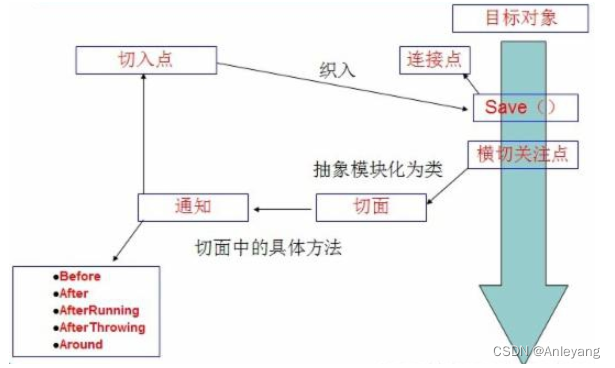
SpringAOP中,通过Advice定义横切逻辑,Spring中支持5种类型的Advice:
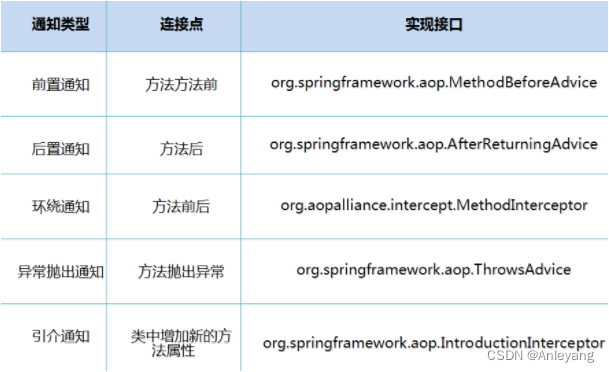
即 Aop 在 不改变原有代码的情况下 , 去增加新的功能。
11.3、使用Spring 实现AOP
【重点】使用AOP织入,需要导入一个依赖包!
<!-- https://mvnrepository.com/artifact/org.aspectj/aspectjweaver -->
<dependency>
<groupId>org.aspectj</groupId>
<artifactId>aspectjweaver</artifactId>
<version>1.9.4</version>
</dependency>
方式一:使用Spring 的API接口【使用SpringAPI接口实现】
首先编写我们的业务接口和实现类
public interface UserService {
public void add();
public void delete();
public void update();
public void search();
}
public class UserServiceImpl implements UserService{
@Override
public void add() {
System.out.println("增加用户");
}
@Override
public void delete() {
System.out.println("删除用户");
}
@Override
public void update() {
System.out.println("更新用户");
}
@Override
public void search() {
System.out.println("查询用户");
}
}
然后去写我们的增强类 , 我们编写两个 , 一个前置增强 一个后置增强
public class Log implements MethodBeforeAdvice {
//method : 要执行的目标对象的方法
//objects : 被调用的方法的参数
//Object : 目标对象
@Override
public void before(Method method, Object[] objects, Object o) throws Throwable {
System.out.println( o.getClass().getName() + "的" + method.getName() + "方法被执行了");
}
}
public class AfterLog implements AfterReturningAdvice {
//returnValue 返回值
//method被调用的方法
//args 被调用的方法的对象的参数
//target 被调用的目标对象
@Override
public void afterReturning(Object returnValue, Method method, Object[] args, Object target) throws Throwable {
System.out.println("执行了" + target.getClass().getName()
+"的"+method.getName()+"方法,"
+"返回值:"+returnValue);
}
}
最后去spring的文件中注册 , 并实现aop切入实现 , 注意导入约束
<?xml version="1.0" encoding="UTF-8"?>
<beans xmlns="http://www.springframework.org/schema/beans"
xmlns:xsi="http://www.w3.org/2001/XMLSchema-instance"
xmlns:aop="http://www.springframework.org/schema/aop"
xsi:schemaLocation="http://www.springframework.org/schema/beans
http://www.springframework.org/schema/beans/spring-beans.xsd
http://www.springframework.org/schema/aop
http://www.springframework.org/schema/aop/spring-aop.xsd">
<!--注册bean-->
<bean id="userService" class="com.kuang.service.UserServiceImpl"/>
<bean id="log" class="com.kuang.log.Log"/>
<bean id="afterLog" class="com.kuang.log.AfterLog"/>
<!--aop的配置-->
<aop:config>
<!--切入点 expression:表达式匹配要执行的方法-->
<aop:pointcut id="pointcut" expression="execution(* com.kuang.service.UserServiceImpl.*(..))"/>
<!--执行环绕; advice-ref执行方法 . pointcut-ref切入点-->
<aop:advisor advice-ref="log" pointcut-ref="pointcut"/>
<aop:advisor advice-ref="afterLog" pointcut-ref="pointcut"/>
</aop:config>
</beans>
测试
public class MyTest {
@Test
public void test(){
ApplicationContext context = new ClassPathXmlApplicationContext("beans.xml");
UserService userService = (UserService) context.getBean("userService");
userService.search();
}
}
op的重要性 : 很重要 . 一定要理解其中的思路 , 主要是思想的理解这一块 .
Spring的Aop就是将公共的业务 (日志 , 安全等) 和领域业务结合起来 , 当执行领域业务时 , 将会把公共业务加进来 . 实现公共业务的重复利用 . 领域业务更纯粹 , 程序猿专注领域业务 , 其本质还是动态代理 .
方式二:自定义来实现AOP【主要是切面定义】
目标业务类不变依旧是userServiceImpl
写我们自己的一个切入类
public class DiyPointcut {
public void before(){
System.out.println("---------方法执行前---------");
}
public void after(){
System.out.println("---------方法执行后---------");
}
}
去Spring中配置
<!--第二种方式自定义实现-->
<!--注册bean-->
<bean id="diy" class="com.kuang.config.DiyPointcut"/>
<!--aop的配置-->
<aop:config>
<!--第二种方式:使用AOP的标签实现-->
<!--自定义切面,ref要引用的类-->
<aop:aspect ref="diy">
<!--切入点-->
<aop:pointcut id="diyPonitcut" expression="execution(* com.kuang.service.UserServiceImpl.*(..))"/>
<!--通知-->
<aop:before pointcut-ref="diyPonitcut" method="before"/>
<aop:after pointcut-ref="diyPonitcut" method="after"/>
</aop:aspect>
</aop:config>
测试:
public class MyTest {
@Test
public void test(){
ApplicationContext context = new ClassPathXmlApplicationContext("beans.xml");
UserService userService = (UserService) context.getBean("userService");
userService.add();
}
}
方式三:使用注解实现
第一步:编写一个注解实现的增强类
package com.kuang.config;
import org.aspectj.lang.ProceedingJoinPoint;
import org.aspectj.lang.annotation.After;
import org.aspectj.lang.annotation.Around;
import org.aspectj.lang.annotation.Aspect;
import org.aspectj.lang.annotation.Before;
@Aspect
public class AnnotationPointcut {
@Before("execution(* com.kuang.service.UserServiceImpl.*(..))")
public void before(){
System.out.println("---------方法执行前---------");
}
@After("execution(* com.kuang.service.UserServiceImpl.*(..))")
public void after(){
System.out.println("---------方法执行后---------");
}
@Around("execution(* com.kuang.service.UserServiceImpl.*(..))")
public void around(ProceedingJoinPoint jp) throws Throwable {
System.out.println("环绕前");
System.out.println("签名:"+jp.getSignature());
//执行目标方法proceed
Object proceed = jp.proceed();
System.out.println("环绕后");
System.out.println(proceed);
}
}
第二步:在Spring配置文件中,注册bean,并增加支持注解的配置
<!--第三种方式:注解实现-->
<bean id="annotationPointcut" class="com.kuang.config.AnnotationPointcut"/>
<aop:aspectj-autoproxy/>
aop:aspectj-autoproxy:说明
通过aop命名空间的<aop:aspectj-autoproxy />声明自动为spring容器中那些配置@aspectJ切面的bean创建代理,织入切面。
当然,spring 在内部依旧采用AnnotationAwareAspectJAutoProxyCreator进行自动代理的创建工作,但具体实现的细节已经
被<aop:aspectj-autoproxy />隐藏起来了
<aop:aspectj-autoproxy />有一个proxy-target-class属性,默认为false,表示使用jdk动态代理织入增强,当配为
<aop:aspectj-autoproxy poxy-target-class="true"/>时,表示使用CGLib动态代理技术织入增强。不过即使proxy-target-class设置
为false,如果目标类没有声明接口,则spring将自动使用CGLib动态代理。
12、整合Mybatis
步骤:
- 导入相关jar包
- Junit
- mybatis
- mysql数据库
- spring相关的
- aop织入
- mybatis-spring
- 编写配置文件
- 测试
步骤:
-
导入相关jar包
- Junit
<dependency> <groupId>junit</groupId> <artifactId>junit</artifactId> <version>4.12</version> </dependency>-
mybatis
<dependency> <groupId>org.mybatis</groupId> <artifactId>mybatis</artifactId> <version>3.5.2</version> </dependency> -
mysql数据库 mysql-connector-java
<dependency> <groupId>mysql</groupId> <artifactId>mysql-connector-java</artifactId> <version>5.1.47</version> </dependency> -
spring相关
<dependency> <groupId>org.springframework</groupId> <artifactId>spring-webmvc</artifactId> <version>5.1.10.RELEASE</version> </dependency> <dependency> <groupId>org.springframework</groupId> <artifactId>spring-jdbc</artifactId> <version>5.1.10.RELEASE</version> </dependency> -
aspectJ AOP 织入器
<!-- https://mvnrepository.com/artifact/org.aspectj/aspectjweaver --> <dependency> <groupId>org.aspectj</groupId> <artifactId>aspectjweaver</artifactId> <version>1.9.4</version> </dependency> -
mybatis-spring整合包 【重点】
<dependency> <groupId>org.mybatis</groupId> <artifactId>mybatis-spring</artifactId> <version>2.0.2</version> </dependency> -
配置Maven静态资源过滤问题!
<build> <resources> <resource> <directory>src/main/java</directory> <includes> <include>**/*.properties</include> <include>**/*.xml</include> </includes> <filtering>true</filtering> </resource> </resources> </build>
-
编写配置文件
-
测试
12.1、回忆Mybatis
编写pojo实体类
package com.kuang.pojo;
public class User {
private int id; //id
private String name; //姓名
private String pwd; //密码
}
实现mybatis的配置文件
<?xml version="1.0" encoding="UTF-8" ?>
<!DOCTYPE configuration
PUBLIC "-//mybatis.org//DTD Config 3.0//EN"
"http://mybatis.org/dtd/mybatis-3-config.dtd">
<configuration>
<typeAliases>
<package name="com.kuang.pojo"/>
</typeAliases>
<environments default="development">
<environment id="development">
<transactionManager type="JDBC"/>
<dataSource type="POOLED">
<property name="driver" value="com.mysql.jdbc.Driver"/>
<property name="url" value="jdbc:mysql://localhost:3306/mybatis?useSSL=true&useUnicode=true&characterEncoding=utf8"/>
<property name="username" value="root"/>
<property name="password" value="123456"/>
</dataSource>
</environment>
</environments>
<mappers>
<package name="com.kuang.dao"/>
</mappers>
</configuration>
UserDao接口编写
public interface UserMapper {
public List<User> selectUser();
}
接口对应的Mapper映射文件
<?xml version="1.0" encoding="UTF-8" ?>
<!DOCTYPE mapper
PUBLIC "-//mybatis.org//DTD Mapper 3.0//EN"
"http://mybatis.org/dtd/mybatis-3-mapper.dtd">
<mapper namespace="com.kuang.dao.UserMapper">
<select id="selectUser" resultType="User">
select * from user
</select>
</mapper>
测试类
@Test
public void selectUser() throws IOException {
String resource = "mybatis-config.xml";
InputStream inputStream = Resources.getResourceAsStream(resource);
SqlSessionFactory sqlSessionFactory = new SqlSessionFactoryBuilder().build(inputStream);
SqlSession sqlSession = sqlSessionFactory.openSession();
UserMapper mapper = sqlSession.getMapper(UserMapper.class);
List<User> userList = mapper.selectUser();
for (User user: userList){
System.out.println(user);
}
sqlSession.close();
}
12.2、MyBatis-Spring学习
引入Spring之前需要了解mybatis-spring包中的一些重要类;
http://www.mybatis.org/spring/zh/index.html

什么是 MyBatis-Spring?
MyBatis-Spring 会帮助你将 MyBatis 代码无缝地整合到 Spring 中。
知识基础
在开始使用 MyBatis-Spring 之前,你需要先熟悉 Spring 和 MyBatis 这两个框架和有关它们的术语。这很重要
MyBatis-Spring 需要以下版本:
| MyBatis-Spring | MyBatis | Spring 框架 | Spring Batch | Java |
|---|---|---|---|---|
| 2.0 | 3.5+ | 5.0+ | 4.0+ | Java 8+ |
| 1.3 | 3.4+ | 3.2.2+ | 2.1+ | Java 6+ |
如果使用 Maven 作为构建工具,仅需要在 pom.xml 中加入以下代码即可:
<dependency>
<groupId>org.mybatis</groupId>
<artifactId>mybatis-spring</artifactId>
<version>2.0.2</version>
</dependency>
要和 Spring 一起使用 MyBatis,需要在 Spring 应用上下文中定义至少两样东西:一个 SqlSessionFactory 和至少一个数据映射器类。
在 MyBatis-Spring 中,可使用 SqlSessionFactoryBean来创建 SqlSessionFactory。 要配置这个工厂 bean,只需要把下面代码放在 Spring 的 XML 配置文件中:
<bean id="sqlSessionFactory" class="org.mybatis.spring.SqlSessionFactoryBean">
<property name="dataSource" ref="dataSource" />
</bean>
注意:SqlSessionFactory 需要一个 DataSource(数据源)。 这可以是任意的 DataSource,只需要和配置其它 Spring 数据库连接一样配置它就可以了。
在基础的 MyBatis 用法中,是通过 SqlSessionFactoryBuilder 来创建 SqlSessionFactory 的。 而在 MyBatis-Spring 中,则使用 SqlSessionFactoryBean 来创建。
在 MyBatis 中,你可以使用 SqlSessionFactory 来创建 SqlSession。一旦你获得一个 session 之后,你可以使用它来执行映射了的语句,提交或回滚连接,最后,当不再需要它的时候,你可以关闭 session。
SqlSessionFactory 有一个唯一的必要属性:用于 JDBC 的 DataSource。这可以是任意的 DataSource 对象,它的配置方法和其它 Spring 数据库连接是一样的。
一个常用的属性是 configLocation,它用来指定 MyBatis 的 XML 配置文件路径。它在需要修改 MyBatis 的基础配置非常有用。通常,基础配置指的是 <settings> 或 <typeAliases> 元素。
需要注意的是,这个配置文件并不需要是一个完整的 MyBatis 配置。确切地说,任何环境配置(<environments>),数据源(<DataSource>)和 MyBatis 的事务管理器(<transactionManager>)都会被忽略。SqlSessionFactoryBean 会创建它自有的 MyBatis 环境配置(Environment),并按要求设置自定义环境的值。
SqlSessionTemplate 是 MyBatis-Spring 的核心。作为 SqlSession 的一个实现,这意味着可以使用它无缝代替你代码中已经在使用的 SqlSession。
模板可以参与到 Spring 的事务管理中,并且由于其是线程安全的,可以供多个映射器类使用,你应该总是用 SqlSessionTemplate 来替换 MyBatis 默认的 DefaultSqlSession 实现。在同一应用程序中的不同类之间混杂使用可能会引起数据一致性的问题。
可以使用 SqlSessionFactory 作为构造方法的参数来创建 SqlSessionTemplate 对象。
<bean id="sqlSession" class="org.mybatis.spring.SqlSessionTemplate">
<constructor-arg index="0" ref="sqlSessionFactory" />
</bean>
现在,这个 bean 就可以直接注入到你的 DAO bean 中了。你需要在你的 bean 中添加一个 SqlSession 属性,就像下面这样:
public class UserDaoImpl implements UserDao {
private SqlSession sqlSession;
public void setSqlSession(SqlSession sqlSession) {
this.sqlSession = sqlSession;
}
public User getUser(String userId) {
return sqlSession.getMapper...;
}
}
按下面这样,注入 SqlSessionTemplate:
<bean id="userDao" class="org.mybatis.spring.sample.dao.UserDaoImpl">
<property name="sqlSession" ref="sqlSession" />
</bean>
12.3、整合实现一
引入Spring配置文件beans.xml
<?xml version="1.0" encoding="UTF-8"?>
<beans xmlns="http://www.springframework.org/schema/beans"
xmlns:xsi="http://www.w3.org/2001/XMLSchema-instance"
xsi:schemaLocation="http://www.springframework.org/schema/beans
http://www.springframework.org/schema/beans/spring-beans.xsd">
配置数据源替换mybaits的数据源
<!--配置数据源:数据源有非常多,可以使用第三方的,也可使使用Spring的-->
<bean id="dataSource" class="org.springframework.jdbc.datasource.DriverManagerDataSource">
<property name="driverClassName" value="com.mysql.jdbc.Driver"/>
<property name="url" value="jdbc:mysql://localhost:3306/mybatis?useSSL=true&useUnicode=true&characterEncoding=utf8"/>
<property name="username" value="root"/>
<property name="password" value="123456"/>
</bean>
配置SqlSessionFactory,关联MyBatis
<!--配置SqlSessionFactory-->
<bean id="sqlSessionFactory" class="org.mybatis.spring.SqlSessionFactoryBean">
<property name="dataSource" ref="dataSource"/>
<!--关联Mybatis-->
<property name="configLocation" value="classpath:mybatis-config.xml"/>
<property name="mapperLocations" value="classpath:com/kuang/dao/*.xml"/>
</bean>
注册sqlSessionTemplate,关联sqlSessionFactory;
<!--注册sqlSessionTemplate , 关联sqlSessionFactory-->
<bean id="sqlSession" class="org.mybatis.spring.SqlSessionTemplate">
<!--利用构造器注入-->
<constructor-arg index="0" ref="sqlSessionFactory"/>
</bean>
增加Dao接口的实现类;私有化sqlSessionTemplate
public class UserDaoImpl implements UserMapper {
//sqlSession不用我们自己创建了,Spring来管理
private SqlSessionTemplate sqlSession;
public void setSqlSession(SqlSessionTemplate sqlSession) {
this.sqlSession = sqlSession;
}
public List<User> selectUser() {
UserMapper mapper = sqlSession.getMapper(UserMapper.class);
return mapper.selectUser();
}
}
注册bean实现
<bean id="userDao" class="com.kuang.dao.UserDaoImpl">
<property name="sqlSession" ref="sqlSession"/>
</bean>
测试
@Test
public void test2(){
ApplicationContext context = new ClassPathXmlApplicationContext("beans.xml");
UserMapper mapper = (UserMapper) context.getBean("userDao");
List<User> user = mapper.selectUser();
System.out.println(user);
}
结果成功输出!现在我们的Mybatis配置文件的状态!发现都可以被Spring整合!
<?xml version="1.0" encoding="UTF-8" ?>
<!DOCTYPE configuration
PUBLIC "-//mybatis.org//DTD Config 3.0//EN"
"http://mybatis.org/dtd/mybatis-3-config.dtd">
<configuration>
<typeAliases>
<package name="com.kuang.pojo"/>
</typeAliases>
</configuration>
12.4、整合实现二
mybatis-spring1.2.3版以上的才有这个 .
官方文档截图 :
dao继承Support类 , 直接利用 getSqlSession() 获得 , 然后直接注入SqlSessionFactory . 比起方式1 , 不需要管理SqlSessionTemplate , 而且对事务的支持更加友好 . 可跟踪源码查看
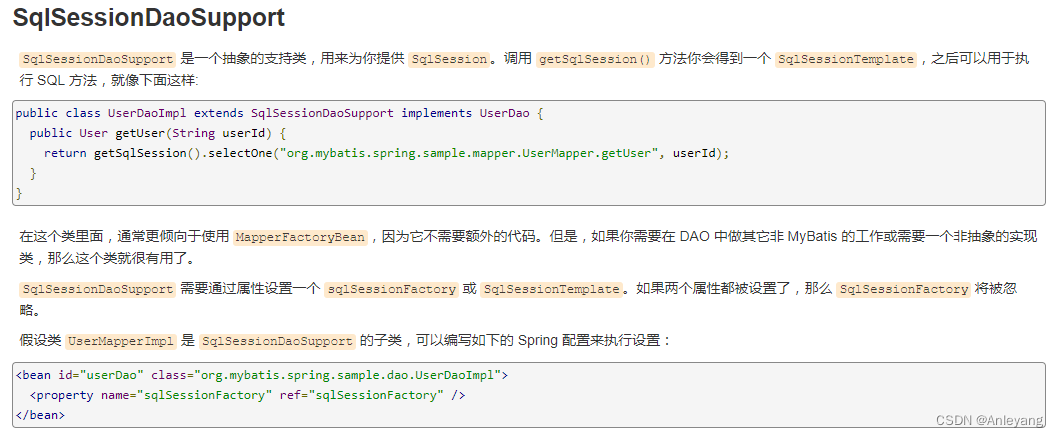
测试:
-
将我们上面写的UserDaoImpl修改一下
public class UserDaoImpl extends SqlSessionDaoSupport implements UserMapper { public List<User> selectUser() { UserMapper mapper = getSqlSession().getMapper(UserMapper.class); return mapper.selectUser(); } } -
修改bean的配置
<bean id="userDao" class="com.kuang.dao.UserDaoImpl"> <property name="sqlSessionFactory" ref="sqlSessionFactory" /> </bean> -
测试
@Test public void test2(){ ApplicationContext context = new ClassPathXmlApplicationContext("beans.xml"); UserMapper mapper = (UserMapper) context.getBean("userDao"); List<User> user = mapper.selectUser(); System.out.println(user); }
总结 : 整合到spring中以后可以完全不要mybatis的配置文件,除了这些方式可以实现整合之外,我们还可以使用注解来实现,这个等我们后面学习SpringBoot的时候还会测试整合!
13、声明式事务
13.1、回顾事务
- 把一组业务当成一个业务来做;要么都成功,要么都失败
- 事务在项目开发中,十分的重要,涉及到数据的一致性问题,不能马虎
- 确保完整性和一致性
事务ACID原则:
- 原子性(atomicity):事务是原子性操作,由一系列动作组成,事务的原子性确保动作要么全部完成,要么完全不起作用
- 一致性(consistency):一旦所有事务动作完成,事务就要被提交。数据和资源处于一种满足业务规则的一致性状态中
- 隔离性(isolation):可能多个事务会同时处理相同的数据,因此每个事务都应该与其他事务隔离开来,防止数据损坏
- 持久性(durability):事务一旦完成,无论系统发生什么错误,结果都不会受到影响。通常情况下,事务的结果被写到持久化存储器中
13.2、测试
将上面的代码拷贝到一个新项目中
在之前的案例中,我们给userDao接口新增两个方法,删除和增加用户;
//添加一个用户
int addUser(User user);
//根据id删除用户
int deleteUser(int id);
mapper文件,我们故意把 deletes 写错,测试!
<insert id="addUser" parameterType="com.kuang.pojo.User">
insert into user (id,name,pwd) values (#{id},#{name},#{pwd})
</insert>
<delete id="deleteUser" parameterType="int">
deletes from user where id = #{id}
</delete>
编写接口的实现类,在实现类中,我们去操作一波
public class UserDaoImpl extends SqlSessionDaoSupport implements UserMapper {
//增加一些操作
public List<User> selectUser() {
User user = new User(4,"小明","123456");
UserMapper mapper = getSqlSession().getMapper(UserMapper.class);
mapper.addUser(user);
mapper.deleteUser(4);
return mapper.selectUser();
}
//新增
public int addUser(User user) {
UserMapper mapper = getSqlSession().getMapper(UserMapper.class);
return mapper.addUser(user);
}
//删除
public int deleteUser(int id) {
UserMapper mapper = getSqlSession().getMapper(UserMapper.class);
return mapper.deleteUser(id);
}
}
测试
@Test
public void test2(){
ApplicationContext context = new ClassPathXmlApplicationContext("beans.xml");
UserMapper mapper = (UserMapper) context.getBean("userDao");
List<User> user = mapper.selectUser();
System.out.println(user);
}
报错:sql异常,delete写错了
结果 :插入成功!
没有进行事务的管理;我们想让他们都成功才成功,有一个失败,就都失败,我们就应该需要事务!
以前我们都需要自己手动管理事务,十分麻烦!
但是Spring给我们提供了事务管理,我们只需要配置即可;
13.3、Spring中的事务管理
Spring在不同的事务管理API之上定义了一个抽象层,使得开发人员不必了解底层的事务管理API就可以使用Spring的事务管理机制。Spring支持编程式事务管理和声明式的事务管理。
编程式事务管理:需要在代码中,进行事务的管理
- 将事务管理代码嵌到业务方法中来控制事务的提交和回滚
- 缺点:必须在每个事务操作业务逻辑中包含额外的事务管理代码
声明式事务管理:AOP
- 一般情况下比编程式事务好用。
- 将事务管理代码从业务方法中分离出来,以声明的方式来实现事务管理。
- 将事务管理作为横切关注点,通过aop方法模块化。Spring中通过Spring AOP框架支持声明式事务管理。
使用Spring管理事务,注意头文件的约束导入 : tx
xmlns:tx="http://www.springframework.org/schema/tx"
http://www.springframework.org/schema/tx
http://www.springframework.org/schema/tx/spring-tx.xsd">
事务管理器
- 无论使用Spring的哪种事务管理策略(编程式或者声明式)事务管理器都是必须的。
- 就是 Spring的核心事务管理抽象,管理封装了一组独立于技术的方法。
JDBC事务
<!--配置声明式事务-->
<bean id="transactionManager" class="org.springframework.jdbc.datasource.DataSourceTransactionManager">
<property name="dataSource" ref="dataSource" />
</bean>
配置好事务管理器后我们需要去配置事务的通知
<!--配置事务通知-->
<tx:advice id="txAdvice" transaction-manager="transactionManager">
<tx:attributes>
<!--配置哪些方法使用什么样的事务,配置事务的传播特性-->
<!--新特性add-->
<tx:method name="add" propagation="REQUIRED"/>
<tx:method name="delete" propagation="REQUIRED"/>
<tx:method name="update" propagation="REQUIRED"/>
<tx:method name="search*" propagation="REQUIRED"/>
<tx:method name="get" read-only="true"/>
<!--全部-->
<tx:method name="*" propagation="REQUIRED"/>
</tx:attributes>
</tx:advice>
spring事务传播特性:
事务传播行为就是多个事务方法相互调用时,事务如何在这些方法间传播。spring支持7种事务传播行为:
- propagation_requierd:如果当前没有事务,就新建一个事务,如果已存在一个事务中,加入到这个事务中,这是最常见的选择。
- propagation_supports:支持当前事务,如果没有当前事务,就以非事务方法执行。
- propagation_mandatory:使用当前事务,如果没有当前事务,就抛出异常。
- propagation_required_new:新建事务,如果当前存在事务,把当前事务挂起。
- propagation_not_supported:以非事务方式执行操作,如果当前存在事务,就把当前事务挂起。
- propagation_never:以非事务方式执行操作,如果当前事务存在则抛出异常。
- propagation_nested:如果当前存在事务,则在嵌套事务内执行。如果当前没有事务,则执行与propagation_required类似的操作
Spring 默认的事务传播行为是 PROPAGATION_REQUIRED,它适合于绝大多数的情况。
假设 ServiveX#methodX() 都工作在事务环境下(即都被 Spring 事务增强了),假设程序中存在如下的调用链:Service1#method1()->Service2#method2()->Service3#method3(),那么这 3 个服务类的 3 个方法通过 Spring 的事务传播机制都工作在同一个事务中。
就好比,我们刚才的几个方法存在调用,所以会被放在一组事务当中!
配置AOP
导入aop的头文件!
配置事务切入
<!--配置aop织入事务-->
<aop:config>
<aop:pointcut id="txPointcut" expression="execution(* com.kuang.dao.*.*(..))"/>
<aop:advisor advice-ref="txAdvice" pointcut-ref="txPointcut"/>
</aop:config>
进行测试
删掉刚才插入的数据,再次测试!
@Test
public void test2(){
ApplicationContext context = new ClassPathXmlApplicationContext("beans.xml");
UserMapper mapper = (UserMapper) context.getBean("userDao");
List<User> user = mapper.selectUser();
System.out.println(user);
}
思考:
为什么需要配置事务?
- 如果不配置事务,可能存在数据提交不一致的情况
- 如果我们不在Spring中去配置声明式事务,我们就需要在代码中手动配置事务
- 事务在项目开发过程非常重要,涉及到数据的一致性的问题,不容马虎!
总结
- Spring是一个思想的学习,IOC和AOP
- Spring的优点
- IOC其实就是提供一个Set接口
- 控制反转
- 依赖注入:Set注入
- Bean的自动装配:名字相同、类型唯一就可以在平时开发中使用,不用每次都配
- 使用注解开发:重点关注 Autowired 和 Component
- 代理模式:动态代理、反射
- 整合MyBatis
- 事务:记得导包
参考学习链接:狂神SSM教程